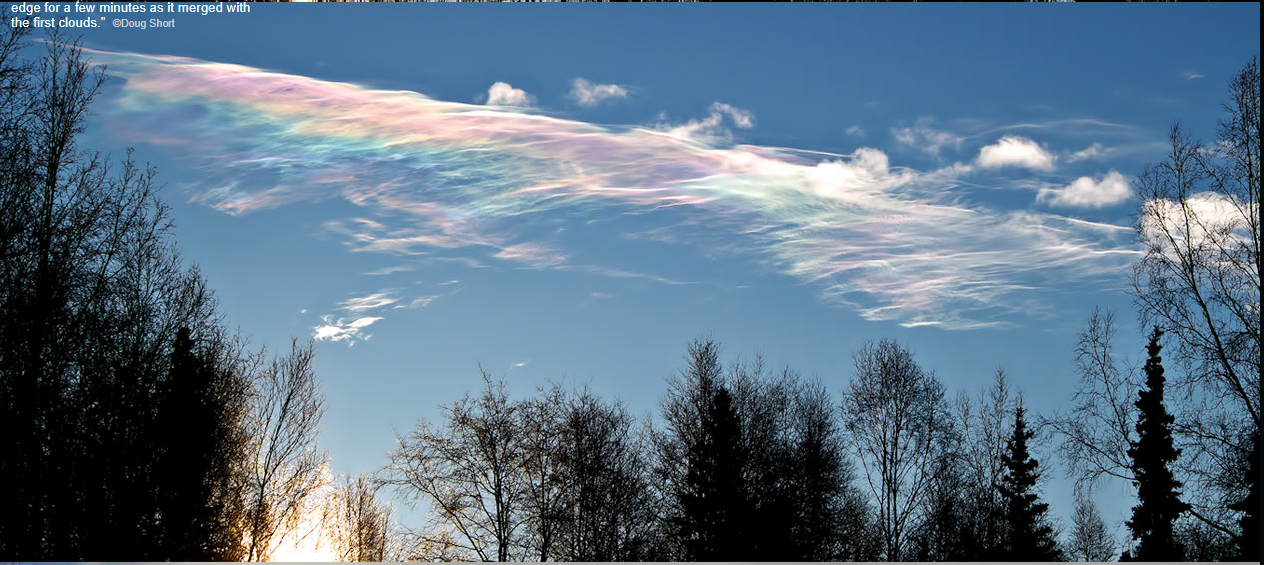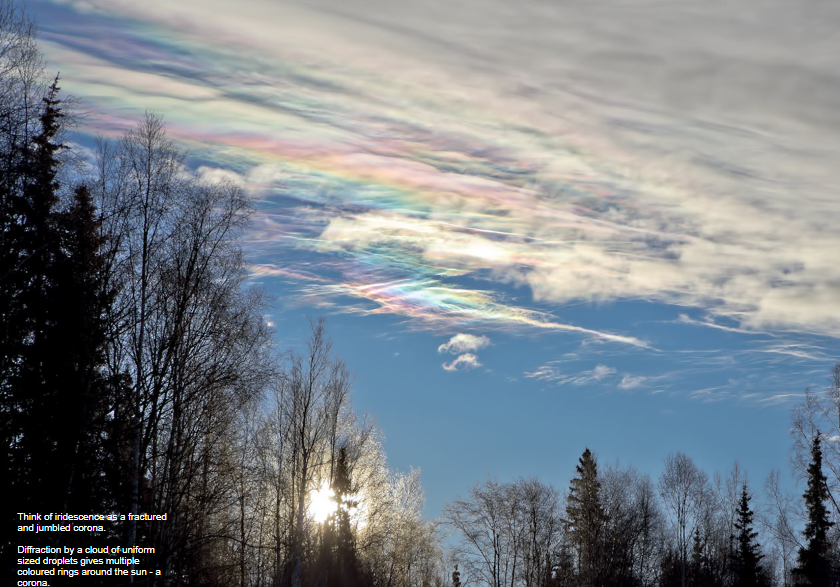OPOD - Alaska Iridescence
OPOD - Alaska Iridescence: A Captivating Display of Nature's Colors
Have you ever witnessed the sky putting on a mesmerizing display of vibrant and ever-changing colors? If not, let us introduce you to the captivating phenomenon known as iridescence. In this article, we will delve into the fascinating world of iridescence, with a special focus on the breathtaking display captured in Alaska by photographer Doug Short.
Iridescence can be best described as a fractured and jumbled corona. To understand this phenomenon, let's first explore the concept of a corona. When sunlight passes through a cloud composed of uniformly sized droplets, diffraction occurs, resulting in multiple colored rings around the sun. This optical phenomenon is known as a corona. However, when the droplet size varies across a cloud, the rings and colors become disordered, creating an ever-changing display of hues known as iridescence.
The images captured by Doug Short in Alaska perfectly showcase this enchanting spectacle. The rapidly changing clouds, illuminated by the sun's rays, exhibited a vivid array of colors for a brief period before merging with a solid layer of clouds. The leading edge of this cloud layer displayed iridescence, adding an extra touch of magic to the scene.
Iridescence is not limited to Alaska; it can occur in various atmospheric conditions around the world. It often manifests in thin clouds, fog, or even in the mist created by waterfalls. The key factor contributing to this phenomenon is the presence of droplets or particles of varying sizes within the atmospheric medium.
The science behind iridescence lies in the interaction between light and these droplets or particles. As sunlight passes through or reflects off these microstructures, it undergoes diffraction, interference, and scattering. These optical processes cause the light waves to interfere with each other, resulting in the splitting and recombination of the different wavelengths. The result is a dazzling display of colors that seem to dance across the sky.
The colors observed during iridescence can vary widely, ranging from pastel shades to vibrant hues. This variation depends on several factors, including the size and distribution of the droplets or particles, the angle of observation, and the properties of the light source itself. Each combination of these factors creates a unique and awe-inspiring display of colors.
To fully appreciate the beauty of iridescence, it is essential to observe it from different angles and perspectives. As you move around, the colors shift and change, creating a dynamic and ever-evolving visual experience. It is like witnessing a natural kaleidoscope in the sky, where each moment brings a new arrangement of colors.
Iridescence not only captivates our eyes but also serves as a reminder of the intricate and interconnected nature of our atmosphere. The presence of varying droplet sizes within clouds or other atmospheric mediums highlights the complex dynamics at play in our environment. By studying iridescence, scientists gain valuable insights into the properties of these droplets and particles, contributing to our understanding of atmospheric optics as a whole.
In conclusion, the phenomenon of iridescence offers us a glimpse into the wonders of nature's color palette. From the enchanting display captured in Alaska by Doug Short to its occurrence in various atmospheric conditions worldwide, iridescence never fails to leave us in awe. The interplay between light and droplets or particles creates a mesmerizing dance of colors that invites us to appreciate the beauty and complexity of our atmosphere. So, next time you find yourself gazing at the sky, keep an eye out for the ever-changing hues of iridescence and let yourself be enchanted by this magnificent natural phenomenon.

Alaska Iridescence captured by Doug Short."These clouds were changing fast and within 10 minutes were overtaken by a solid layer of clouds. The cloud layer showed some iridescence on its leading edge for a few minutes as it merged with the first clouds." ©Doug Short


Think of iridescence as a fractured and jumbled corona.
Diffraction by a cloud of uniform sized droplets gives multiple coloured rings around the sun - a corona.
When the droplet size varies across a cloud the rings and colours are disordered, changing from place to place - iridescence.
Note: this article has been automatically converted from the old site and may not appear as intended. You can find the original article here.
Reference Atmospheric Optics
If you use any of the definitions, information, or data presented on Atmospheric Optics, please copy the link or reference below to properly credit us as the reference source. Thank you!
-
<a href="https://atoptics.co.uk/blog/opod-alaska-iridescence/">OPOD - Alaska Iridescence</a>
-
"OPOD - Alaska Iridescence". Atmospheric Optics. Accessed on November 26, 2024. https://atoptics.co.uk/blog/opod-alaska-iridescence/.
-
"OPOD - Alaska Iridescence". Atmospheric Optics, https://atoptics.co.uk/blog/opod-alaska-iridescence/. Accessed 26 November, 2024
-
OPOD - Alaska Iridescence. Atmospheric Optics. Retrieved from https://atoptics.co.uk/blog/opod-alaska-iridescence/.